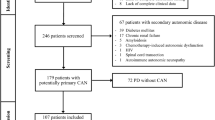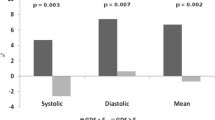Abstract
Objective
Familial dysautonomia (FD) is a rare genetic disease that involves extreme blood pressure fluctuations secondary to afferent baroreflex failure. The diurnal blood pressure profile, including the average, variability, and day–night difference, may have implications for long-term end organ damage. The purpose of this study was to describe the circadian pattern of blood pressure in the FD population and relationships with renal and pulmonary function, use of medications, and overall disability.
Methods
We analyzed 24-h ambulatory blood pressure monitoring recordings in 22 patients with FD. Information about medications, disease severity, renal function (estimated glomerular filtration, eGFR), pulmonary function (forced expiratory volume in 1 s, FEV1) and an index of blood pressure variability (standard deviation of systolic pressure) were analyzed.
Results
The mean (± SEM) 24-h blood pressure was 115 ± 5.6/72 ± 2.0 mmHg. The diurnal blood pressure variability was high (daytime systolic pressure standard deviation 22.4 ± 1.5 mmHg, nighttime 17.2 ± 1.6), with a high frequency of a non-dipping pattern (16 patients, 73%). eGFR, use of medications, FEV1, and disability scores were unrelated to the degree of blood pressure variability or to dipping status.
Interpretation
This FD cohort had normal average 24-h blood pressure, fluctuating blood pressure, and a high frequency of non-dippers. Although there was evidence of renal dysfunction based on eGFR and proteinuria, the ABPM profile was unrelated to the measures of end organ dysfunction or to reported disability.



Similar content being viewed by others
Change history
04 April 2020
Unfortunately, the original version of this article contained
References
Slaugenhaupt SA et al (2001) Tissue-specific expression of a splicing mutation in the IKBKAP gene causes familial dysautonomia. Am J Hum Genet 68(3):598–605
Norcliffe-Kaufmann L, Axelrod F, Kaufmann H (2010) Afferent baroreflex failure in familial dysautonomia. Neurology 75(21):1904–1911
Norcliffe-Kaufmann L et al (2013) Hyperdopaminergic crises in familial dysautonomia: a randomized trial of carbidopa. Neurology 80(17):1611–1617
Palma JA et al (2014) Current treatments in familial dysautonomia. Expert Opin Pharmacother 15(18):2653–2671
Norcliffe-Kaufmann L, Axelrod FB, Kaufmann H (2013) Developmental abnormalities, blood pressure variability and renal disease in Riley Day syndrome. J Hum Hypertens 27(1):51–55
Pearson J et al (1980) Renal disease in familial dysautonomia. Kidney Int 17(1):102–112
Okamoto LE et al (2009) Nocturnal blood pressure dipping in the hypertension of autonomic failure. Hypertension 53(2):363–369
van Ittersum FJ et al (1995) Analysis of twenty-four-hour ambulatory blood pressure monitoring: what time period to assess blood pressures during waking and sleeping? J Hypertens 13(9):1053–1058
Fagard R et al (1996) Prediction of the actual awake and asleep blood pressures by various methods of 24 h pressure analysis. J Hypertens 14(5):557–563
Verdecchia P (2000) Prognostic value of ambulatory blood pressure : current evidence and clinical implications. Hypertension 35(3):844–851
Kario K et al (2001) Stroke prognosis and abnormal nocturnal blood pressure falls in older hypertensives. Hypertension 38(4):852–857
Cockcroft DW, Gault MH (1976) Prediction of creatinine clearance from serum creatinine. Nephron 16(1):31–41
Miller MR et al (2005) Standardisation of spirometry. Eur Respir J 26(2):319–338
Celli BR, MacNee W, Force AET (2004) Standards for the diagnosis and treatment of patients with COPD: a summary of the ATS/ERS position paper. Eur Respir J 23(6):932–946
Axelrod FB et al (2012) A rating scale for the functional assessment of patients with familial dysautonomia (Riley Day syndrome). J Pediatr 161(6):1160–1165
Sega R et al (2002) Blood pressure variability and organ damage in a general population: results from the PAMELA study (Pressioni Arteriose Monitorate E Loro Associazioni). Hypertension 39(2 Pt 2):710–714
Kohara K et al (1995) Autonomic nervous function in non-dipper essential hypertensive subjects. Evaluation by power spectral analysis of heart rate variability. Hypertension 26(5):808–814
Nakano Y et al (2001) Non-dipper phenomenon in essential hypertension is related to blunted nocturnal rise and fall of sympatho-vagal nervous activity and progress in retinopathy. Auton Neurosci 88(3):181–186
Sherwood A et al (2002) Nighttime blood pressure dipping: the role of the sympathetic nervous system. Am J Hypertens 15(2 Pt 1):111–118
Goldstein DS et al (2003) Association between supine hypertension and orthostatic hypotension in autonomic failure. Hypertension 42(2):136–142
Sharabi Y, Goldstein DS (2011) Mechanisms of orthostatic hypotension and supine hypertension in Parkinson disease. J Neurol Sci 310(1–2):123–128
Author information
Authors and Affiliations
Corresponding author
Ethics declarations
Conflict of interest
On behalf of all authors, the corresponding author states that there is no conflict of interest.
Electronic supplementary material
Below is the link to the electronic supplementary material.
Rights and permissions
About this article
Cite this article
Goldberg, L., Bar-Aluma, BE., Krauthammer, A. et al. Ambulatory blood pressure profiles in familial dysautonomia. Clin Auton Res 28, 385–390 (2018). https://doi.org/10.1007/s10286-018-0507-1
Received:
Accepted:
Published:
Issue Date:
DOI: https://doi.org/10.1007/s10286-018-0507-1




